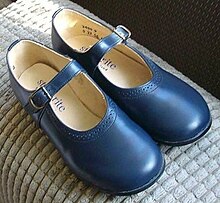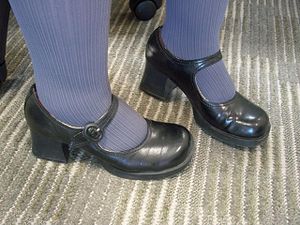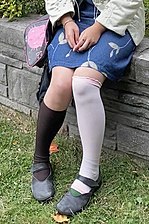This article has multiple issues. Please help improve it or discuss these issues on the talk page . (Learn how and when to remove these messages)
|

Mary Jane (also known as bar shoes, strap shoes or doll shoes) is an American term (formerly a registered trademark) for a closed, low-cut shoe with one or more straps across the instep. [1]
Contents
Classic Mary Janes for children are typically made of black leather or patent leather and have one thin strap fastened with a buckle or button, a broad and rounded toe box, low heels, and thin outsoles. Among girls, Mary Janes are commonly worn with tights, pantyhose, socks, and a dress, or a skirt and blouse. Among boys (less common nowadays), Mary Janes are traditionally worn with socks, short trousers and a shirt. Both genders sometimes wear them without socks, as if they were sandals.




